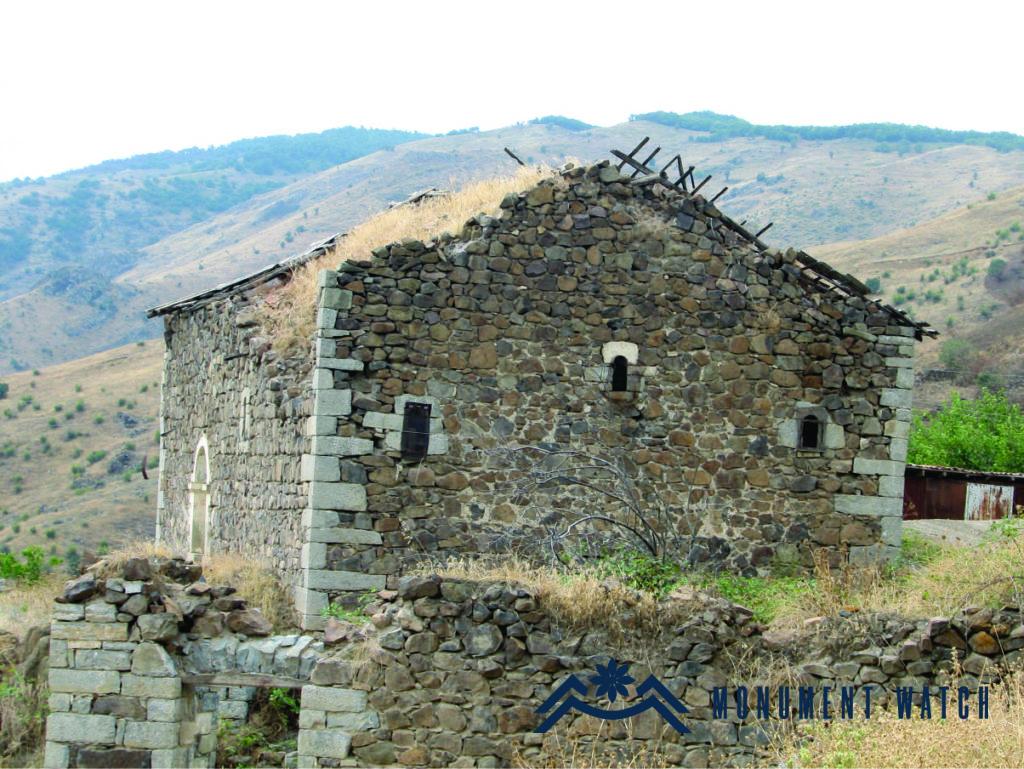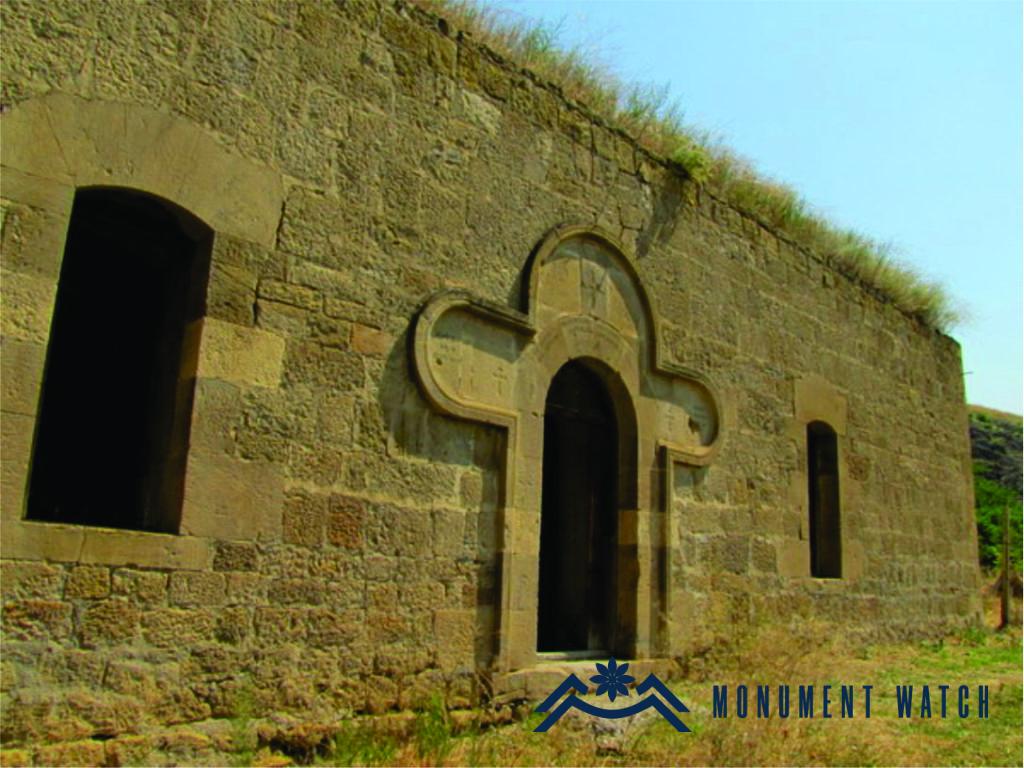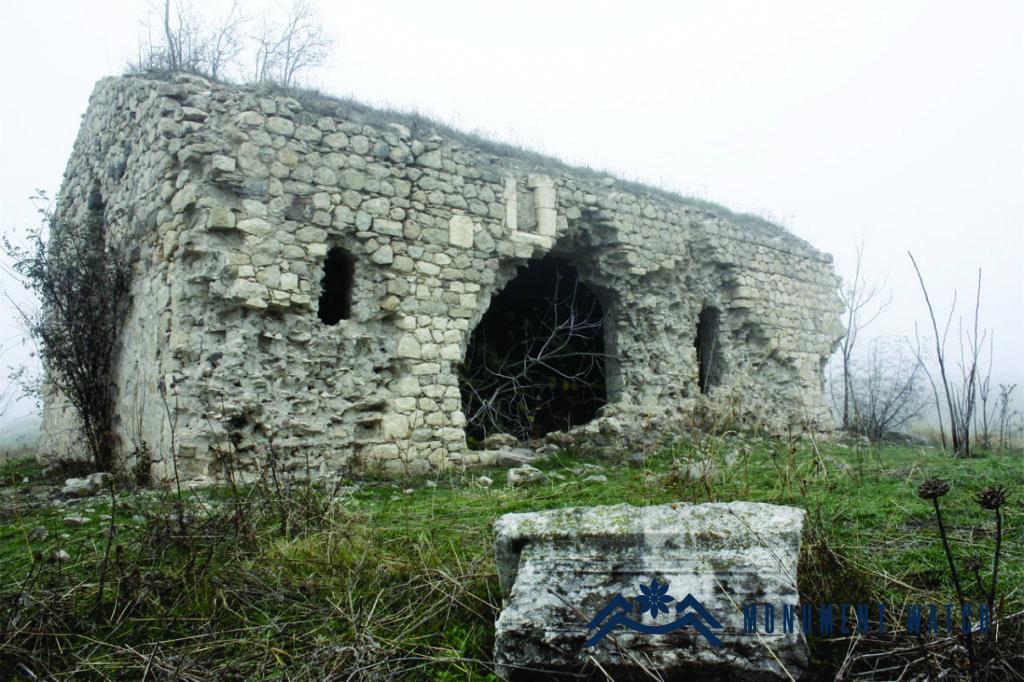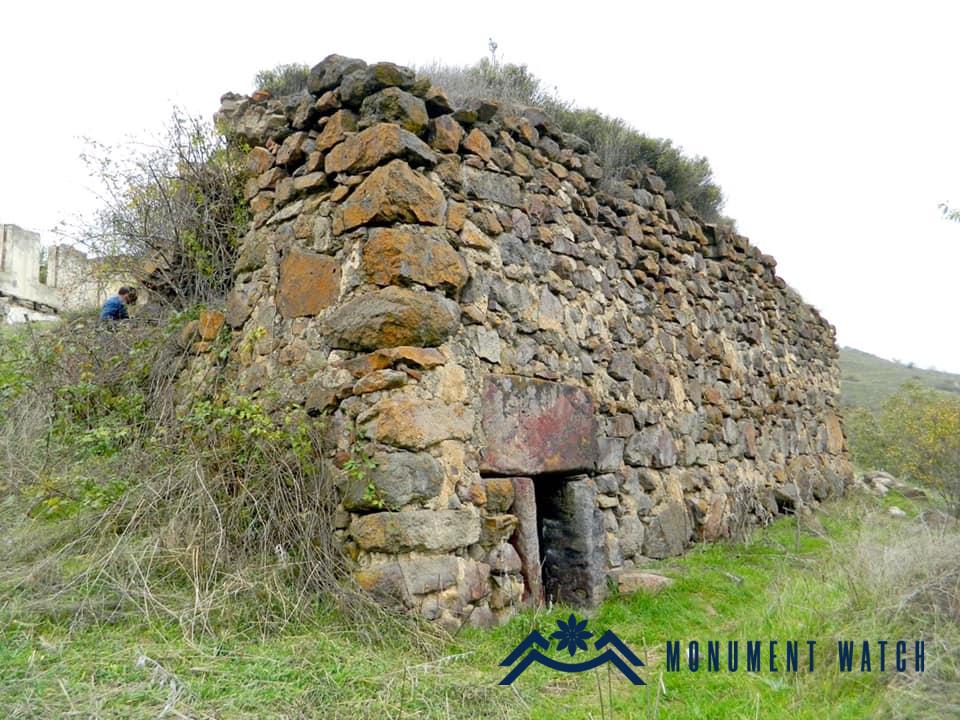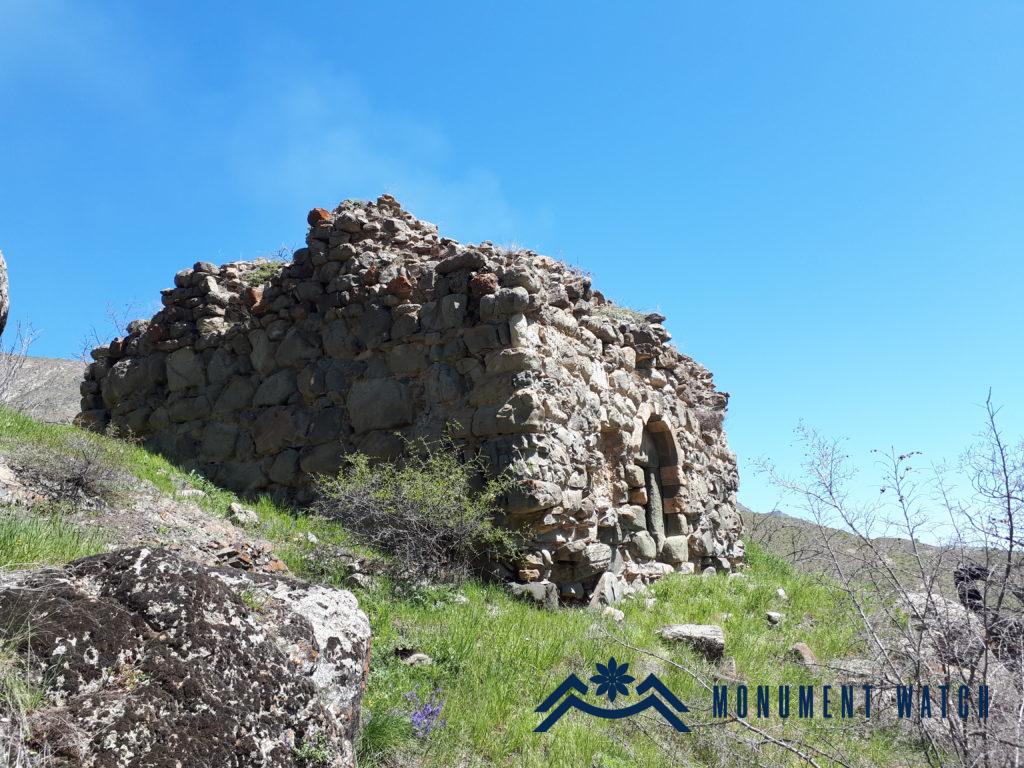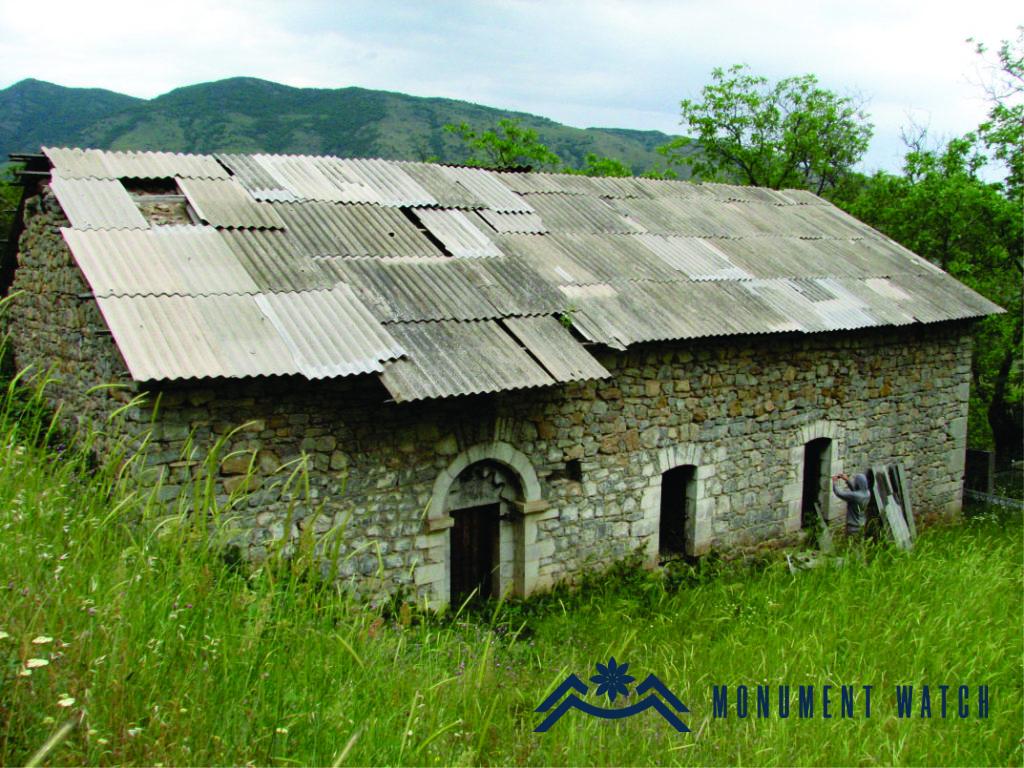
Location The church is located in Tyak village of Hadrut region. Tyak, which has the status of a state reserve since 2017, is one of the settlements where the folk architecture of the 18th-19th centuries has been preserved. Historical overview The church was built in the 19th century (Barkhutaryants 1895, 66). The historical cemetery of the village is located in the vicinity. Architectural-compositional description The monument is a single-nave basilica, built of local rough light brown and gray stones, the frames of the windows, the portal and the cornerstones are made of hewn limestone. The entrance lintel opening to the southern wall is decorated with a knobby arcade typical of the Artsakh churches of the 18th-19th centuries. There are also two windows placed in this wall. The roof used to be originally tiled. It was replaced with slate during the Soviet years. The condition before, during and after the war Before the war the church was completely standing. It was completely restored during 2019-2020 (Fig. 2). No information is known about the monument either during or after the war.
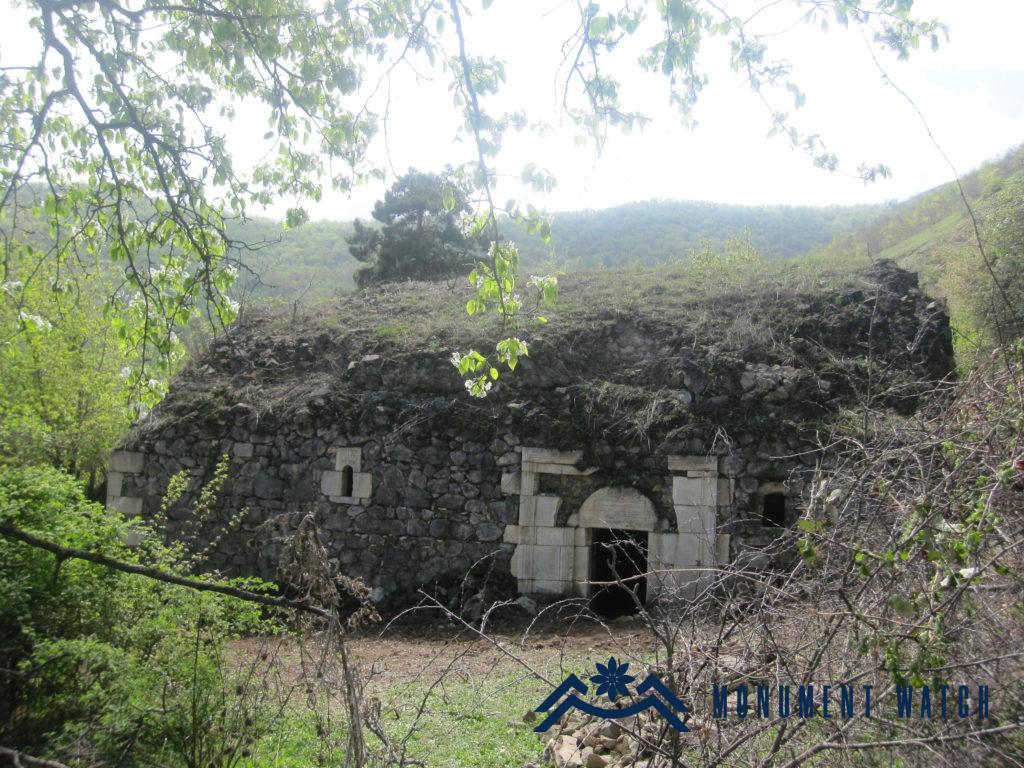
Location The church (Fig. 1) is located at the southern end of Hogher village of Hadrut region, in the area of the old cemetery. Historical overview Hogher village is located on the right bank of the Ishkhanaget River, on the north-eastern mountainous slope of Vnesa fortress, near the villages of Jrakus and Kyuratagh. It was built in the 19th century. Makar Barkhudaryan, who visited Hogher in the 1890s, mentions that: “…the inhabitants are natives, the church is half-finished, the priest comes from Hadrut” (Barkhutarian 1895, 73). The church is mentioned as St. Astvatsatsin in one of the archival documents dated 1880 (Karapetyan 2001, 222). The village was part of Hadrut region until 1938, then joined Koryagino region (Fizuli from 1959), after which the gradual eviction of Armenians from the village began. It was liberated on March 31, 1992 and reappeared under the Azerbaijani occupation in October 2020. Architectural-compositional examination It is a single-nave basilica with a rectangular hall, a semicircular altar on the eastern side, on both sides of which there are the vestries with a rectangular plan (Fig. 2). It is built of local raw stone. The portal, the frames of the windows, the altar and the vestries, the corner edges of the walls and the inner arches are hewn (Fig. 3). It is 15.7 meters long, 8.2 meters wide and 5.5 meters high. The sole entrance opens from the north. The lintel of the portal is patterned, made in the botanical-geometric style widely spread in Shushi and its vicinities, it is inscribed (Fig. 4). It is illuminated through 6 small windows opening from the northern, eastern and southern sides. The stone pool of the baptistery is placed in the northern wall (Fig. 5). The western wall is mostly buried in the ground from the outside, whose upper part and a part of the vault leaning against the western wall are destroyed. There is a cemetery around the church. The condition before, during and after the war St. Astvatsatsin Church used to be in a good condition, there is no information about it during the military operations and its post-war condition.
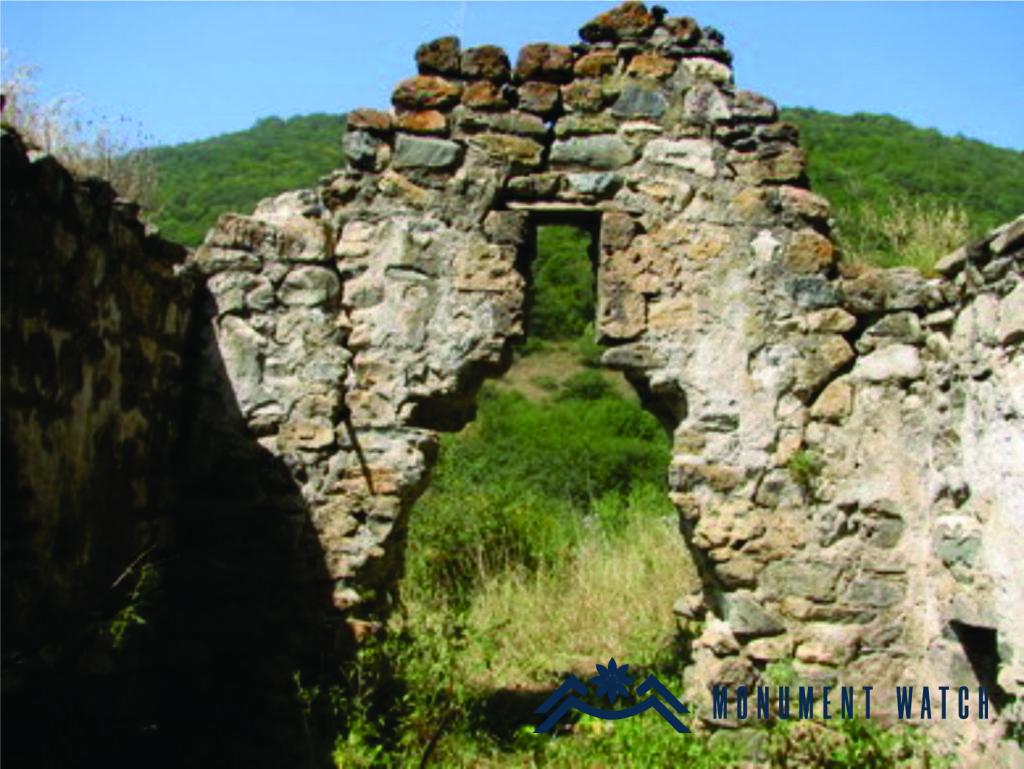
Location Hartagomer rural settlement is located 3,5 km northeast of Khtsaberd village of Hadrut, on the southern slope of Mount Haros, in the hayfield called Yeghtsun Dzor. Historical overview The village was inhabited until the beginning of the 18th century. At the beginning of the 18th century, the inhabitants moved to Shushi district and founded Karintak village. Architectural-compositional examination The church of Yeghtsun Dzor is located in the center of the village, in a semi- dilapidated condition (Fig. 1). It is a monument of the 16th-17th cc., built of local limestone and lime mortar (Fig. 2). It is a single-nave vaulted hall (dimensions: 7.1×5.2 m). The walls have been preserved at a height of 4-5 m. The vaulted roof is collapsed, except for the dome of the conch of the altar. The altar has a semicircular design. In the altar, parallel to the central window opened from the east in the same direction, small khachkars are embedded in the wall, seven of which are preserved in situ in holitic condition (Fig. 3). The entrance is from the west, the illumination is done by one small window opening from the east and the west (Figs. 4, 5, 6).
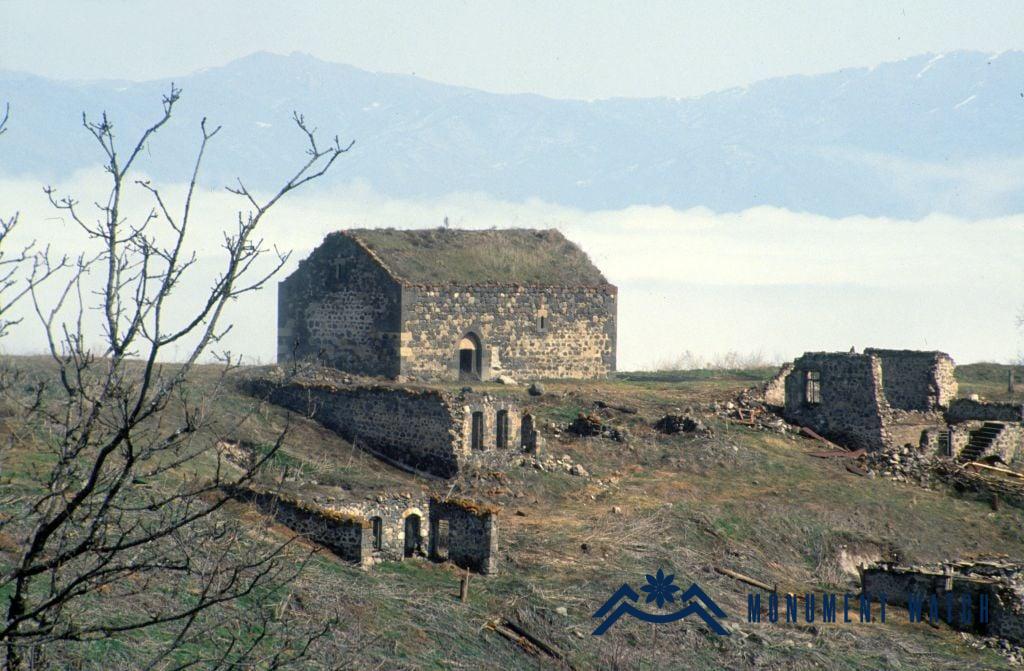
Location The church is located in the centre of the administrative territory of Vanand village of Kashatagh region of the Artsakh Republic (the church was located in Ghubatlu region during the Soviet years). The latter was united in the urban community of Vorotan. The village is located at an altitude of 1250-1310 meters above sea level and in the Middle Ages was called Mazra (Karapetyan 2001, 179). Historical overview There is almost no historical data about the village of Mazra and the church located in its center. The village was emptied of Armenians in the 18th century, because during the construction of the church in 1694, the village was naturally inhabited by Armenians. Architectural-compositional description The church is single-nave in plan, has a vaulted composition with vestries on both sides of the main altar (Fig. 1). The church is located in the center of the village (Fig. 2). It is built of rough and hewn basalt stones (Fig. 3). The dimensions of the church are 14.15X8.15 meters. The only entrance to the church is from the south, whose lintel inscription has been intentionally damaged and is difficult to read (Fig. 4). The 8-line inscription states that it was built by Khoja Petros in his memory and “his spouse, his son Hovhannes, his parents – Malikset, Mary, his brothers Arakel, Margar… the leader and master of the village Hovhannes… Malik Galust, intendant friar Sargis… in the year of 1694” (Karapetyan 2001, 180). During the Soviet years, the church was used by Azerbaijanis as a fodder store. The cruciform window of the eastern facade of the church bears traces of firearms (Fig. 5). Near the southern wall of the church lies a damaged khachkar of the 16th-17th centuries (Fig. 6).
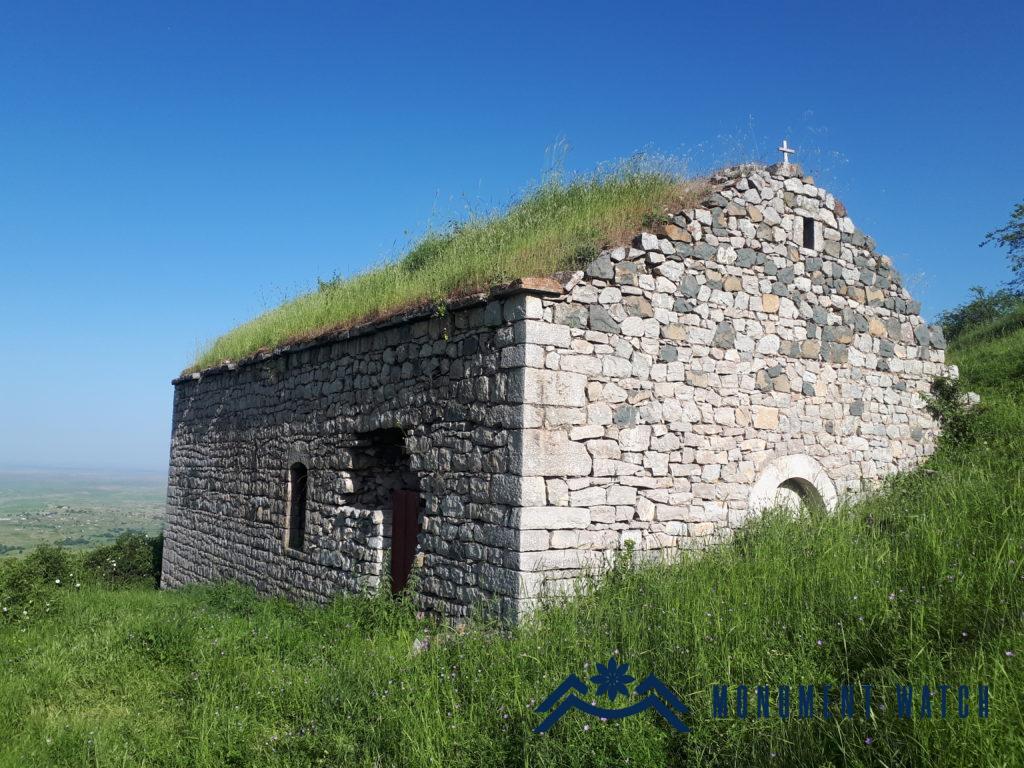
Location Hin (Old) Norashen Church (Fig. 1) is located 1 km south of Norashen village, in the territory of Hin Norashen. Historical overview Norashen village is located in Hadrut region, 5 km southeast of Hadrut town. Azeris settled in the predominantly Armenian-populated village in the 1960s, but as the number gradually increased, the village was finally emptied of Armenians in 1989. It was liberated by the Armenian army in 1993. It has been under Azerbaijani occupation since October 2020. Architectural-compositional examination The church is a single-nave basilica with a rectangular plan. The twin vestries are located on the eastern side, next to the semicircular altar. It is 16.4 meters long, 2 meters wide and 5 meters high. It has 4 small, one big windows. The entrance used to be opened from the west, but due to the slope of the terrain, the western wall was mostly covered with soil, which caused the opening of a new entrance in the northern part (Fig. 2), and from the old entrance only the lintel (Fig. 3) was visible on which a cross relief and the year of the church construction (1892) are carved (Fig. 4). Externally the southern wall is also mostly in the ground (Fig. 5). The roof is gable outwardly and internally vaulted. Two uninscribed simple khachkars have been preserved inside the church. During the Soviet era, the church was turned into a warehouse, then a cheese factory, as a result of which an additional building was built in the hall, whose half-walls have also been preserved (Fig. 6).
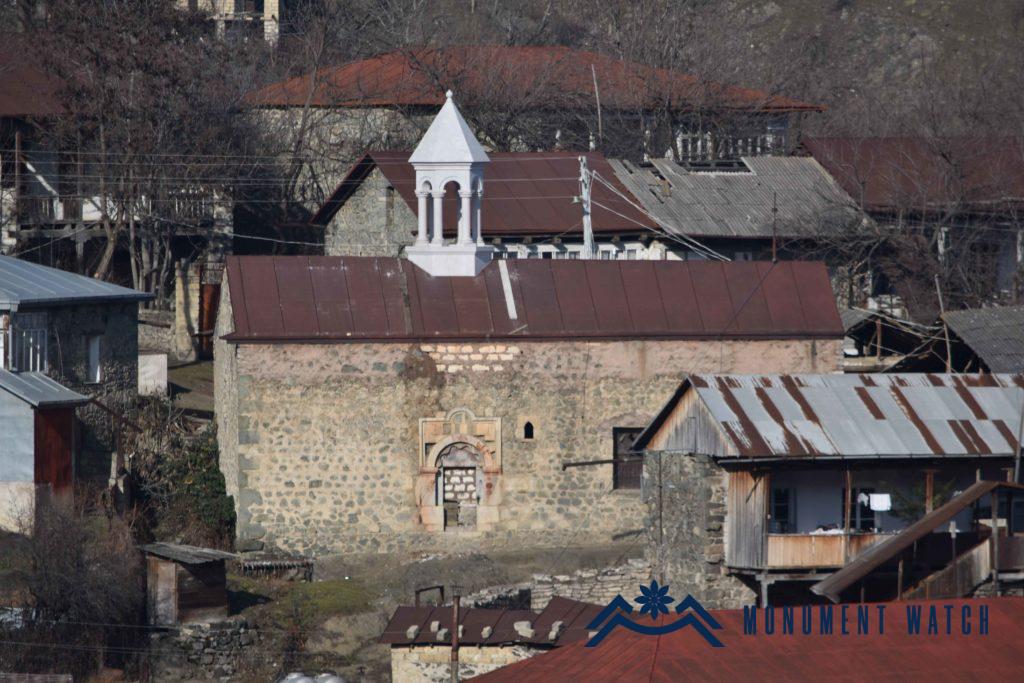
Location The church is located in the center of the old district of Tumi village in Hadrut region of Artsakh. Historical overview Tumi is one of the ancient settlements of Artsakh. It used to be one of the centers of a principality in the southern regions of Artsakh. The rich historical monuments in the village and the surrounding areas are a vivid proof of the said. Karmir Khach (Red Cross) Church in a dilapidated condition, built in 1000, ruins of chapels and a medieval cemetery have been preserved in the village. St. Hovhannes Church (Fig. 1) was built in the 17th century, and underwent significant changes in the 19th century (raising the exterior walls and roofing, enriching the decoration of the portal, in connection with which a cross-ornamented slab was placed in the southern wall of the church and the year of 1868 was engraved), has been preserved. At the end of the 19th century the church functioned and had two priests. Architectural-compositional examination It is a single-nave vaulted hall with a rectangular plan. It is built of local rough gray sandstone, quartz and lime mortar (Fig․ 2). The stones of the entrance facade, windows, pillars, arches and corners of the external walls are hewn. The roof is vaulted, the twin arches of the vaultt rest on pillars (Figs. 3, 4). The entrance is from the south. The illumination was done through small windows opening from the east, south and west. The altar has a semicircular composition. It has two vestries parallel to the altar from the east. Inside, the baptismal font is placed in the northern wall.
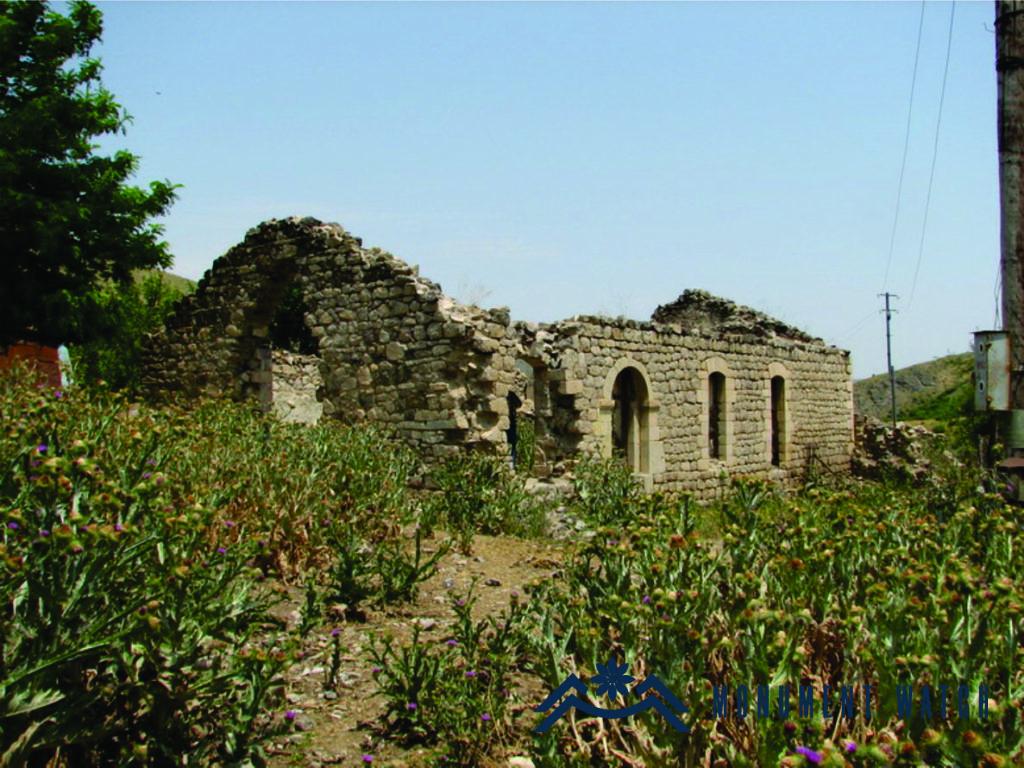
Location St. Astvatsatsin Church is located in Arevashat (Dolanlar) village of Hadrut region of Artsakh. It is in the old district of Arevashat, on the eastern edge of the village (Fig. 1). In the result of the 2020 war, Arevashat as well as the whole region of Hadrut are occupied by Azerbaijan. Architectural-compositional description St. Astvatsatsin Church was built at the beginning of the 20th century. It is a three-nave building with a rectangular plan (Fig. 2). It was built of local rough stones, yellowish limestone and lime mortar. The walls of the interior are plastered. Only the external cornerstones of the doors and windows are hewn. The semicircular altar is on the eastern side. The dome of the altar used to be vaulted, but was not preserved. There are vestries parallel to the altar. The ceiling was timbered, the heaviness of the roof was borne by the wooden pillars. The roof used to be glazed and tiled, which was later replaced with metal sheet. Neither the roof nor the columns have been preserved. The church was destroyed in the years of the First Artsakh War as a result of Operation Ring, during the Azerbaijani occupation of the village (1991-1993), in the result of which not only the church was burned and destroyed (Figs. 3, 4), but also the whole village, the cemetery and almost all the monuments of the area.
Location The church is located on the outskirts of the village, on the roadside (Fig. 1). Historical overview Historical information about the monument is scarce. According to the inscription on the lintel, the church was built in 1889. The inscription says: “We – the residents of Melikjalu village, built St. Harutyun Church in 1889” (Figs. 2, 3). Architectural-compositional description The church has a rectangular plan, it is a single-nave vaulted basilica. The roof, which used to be tiled, has not been preserved (Fig. 4).
Location The church is located in the center of Mataghis village (Fig. 1). Historical overview According to the inscription engraved on the lintel of the southern entrance, the construction of the church took place in 1892-1898. The inscription says: “The Church of St. Yeghisha was built by the united people of Mataghis. It was started in 1892 and was completed in 1898” (Fig. 2). During the visit of M. Barkhudaryants in 1894-1895, the church was still half-built and unconsecrated (Barkhutaryants 1895, 231). Architectural-compositional description The church is a three-nave basilica, built of local light brown rough and hewn stones. The dimensions of the monument are 15.07 meters long and 8.16 meters wide (Figs. 3-4). It is completely plastered inwardly. The semi-circular bema is high, has two vestries, it is vaulted, the roof is covered with earth (Fig. 5). The entrance is from the south, three windows open from the east, two from the south and one from the west.
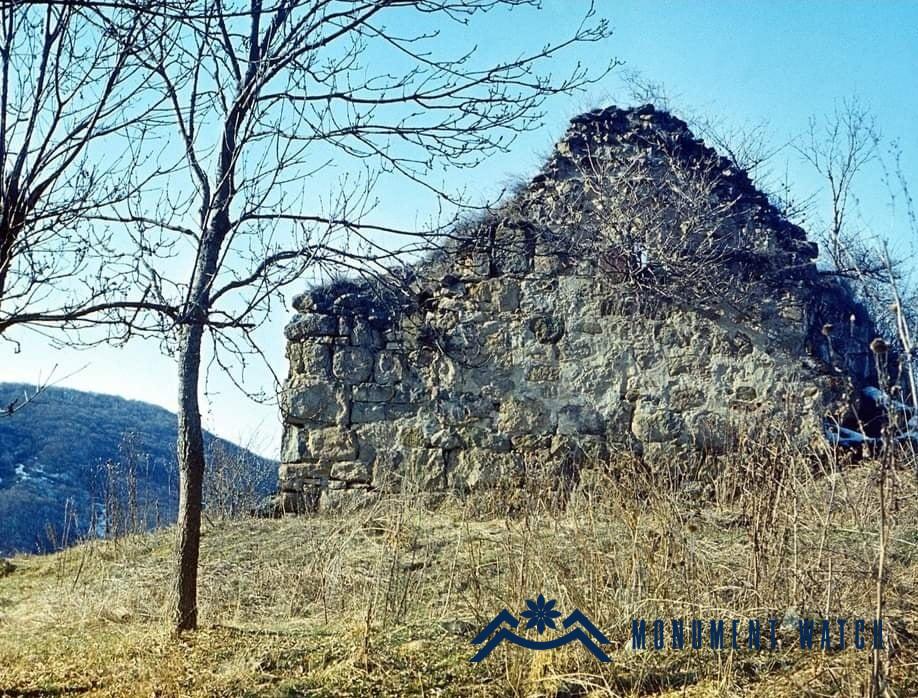
Location The Church of Yeritsushen is located in Nor Shahumyan region (Karvachar region) of the Artsakh Republic, on the right side of the Iritsajur tributary starting from Lake Gortagarak, one kilometer northeast of Igadzor village, 1550-1600 meters above sea level (Karapetyan 2001, 37). Historical overview The only mention of Yeritsushen village can be found in the work “Jambr” by Catholicos Simeon Yerevantsi and concerns the year of 1763 (Jambr 1873, 283). In the 18th century, Turkic-speaking Ayrums settled here, who called the village Keshishkyand (Karapetyan 2001, 42). Architectural-compositional description The church is half-ruined, it was built in the 17th century. It is a single nave hall taken under a gable roof (Fig. 1). The longitudinal walls of the structure are reinforced with rows of arcatures, on which rest the twin hewn arch walls that support the roof. The church is built of rough small and large stones, and the most responsible parts are hewn (Figs. 2, 3). There is one vestry on each side of the altar, but they are different in size. The only entrance to the church is on the southern facade.
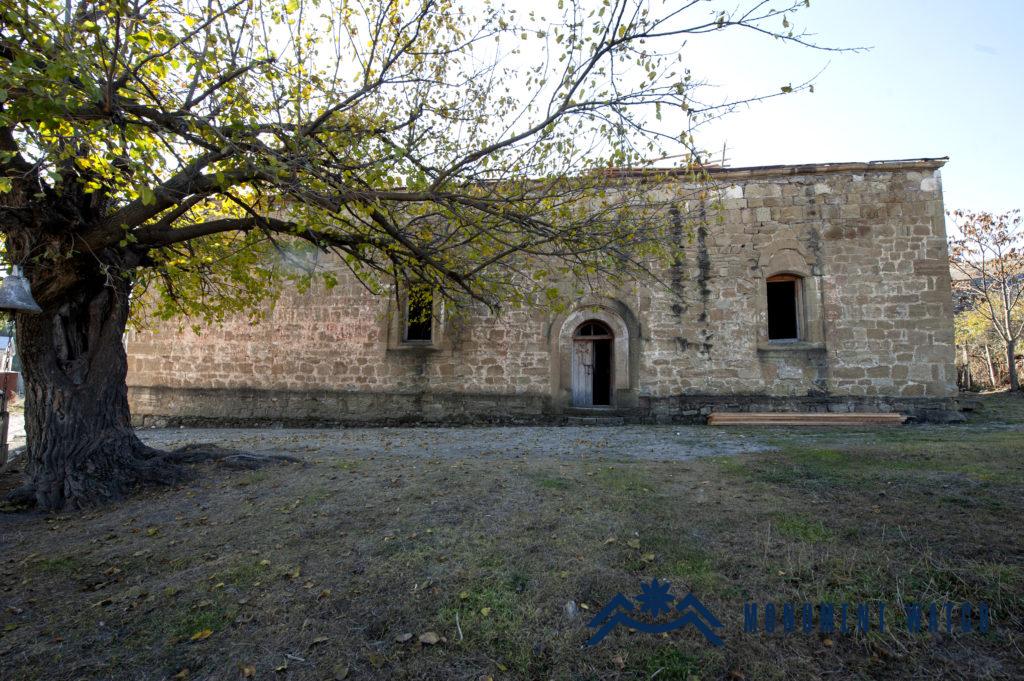
Location The church is located in the village, northeast of the former house of culture. Historical Overview According to M. Barkhudariants, the church was built at the end of the 19th century, more precisely in 1894, at the expense of the local population (Barkhudariants 1895, 226, fig. 1). Architectural-Compositional Description The monument is a three-nave basilica built of local polished and rough light brown stones. Arches resting on eight wall columns and four separate pillars divide the chapel into three naves (fig. 2). The columns and arches are made of hewn stones. The baptismal font is built into the western part of the north wall. The dimensions of the monument are 21.75 meters long and 13.1 meters wide. The church is vaulted; the roof is covered with a sheet of tin tiles. Initially, the church had two doors that opened from the north and south sides (Barkhudariants 1895, 226-227). Later the southern door was closed. The church has three windows on the east, one on the west, two on the north and three on the south. The State of the Church before, during and after the War Before the war the church was completely standing. No information is known about the monument during the war or after it. Bibliographic examination The church is relatively new, which is why the sources are scarce. Our description is based on the information provided by Makar Barkhudariants and that which is submitted by Certificate of Preservation of Monuments of the Ministry of Education, Science, Culture and Sports of the Artsakh Republic, Bibliography 1․ Barkhudariants 1895 – Barkhudariants M. Artsakh, Baku, Aror.
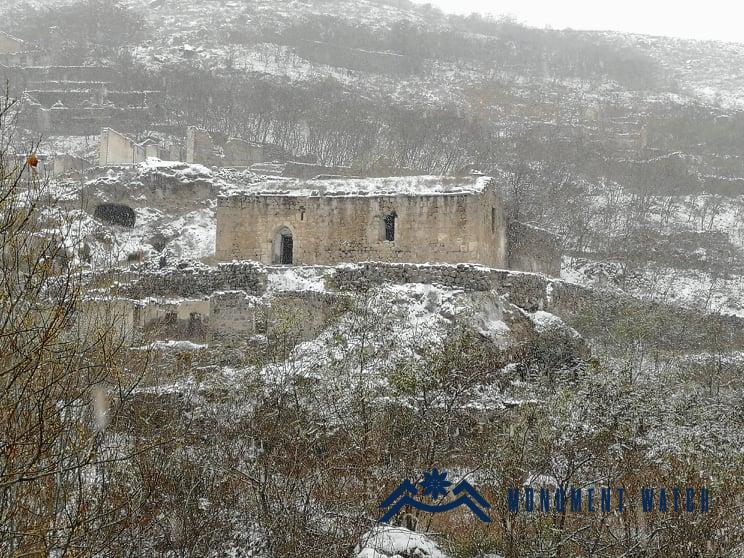
Location The historical village of Stunis is located 2 km south of the village of Ghushchi (Tandzut) in the Kashatagh region (Lachin region) of the Artsakh Republic, on the left bank the Stunis, right inflow of the Aghavnaget River, on its south-eastern gorge. Stunis was first mentioned among the tax-paying villages of Tatev Monastery, and in the 19th century the Kurds settled here, calling the village Sadinlar (Karapetian 1999, 139). The village has been uninhabited since the 1990s. The church is located in the upper part of the village, surrounded by ruined houses (fig. 1). Historical Overview There is no historical information about the church. Architectural-Compositional Description The church is a three-nave basilica with cylindrical vaults, which are taken under a two-pitch roof. The prayer hall ends in the east with a semicircular apse with single sacristies next to it from the south and the north. The walls are lined with large and small rough stones and lime mortar. Fragments of tombstones, khachkars and carved stones of different periods are embedded in the walls, both outside and inside. In its plan and spatial volumetric composition, it is similar to the churches of Mirik, Hak and Herik, and is a 17th-century structure like these. Inside the church, on one of the columns near the entrance, there is a damaged Armenian inscription. The church is plastered inside. The only entrance to the church is on the south side (fig. 2). Large rectangular windows open on the western, southern and eastern fronts (fig. 3). This was possibly done in the 19th century or is not excluded during the Soviet years, when the church, like the Armenian churches in other villages, was turned into a warehouse.
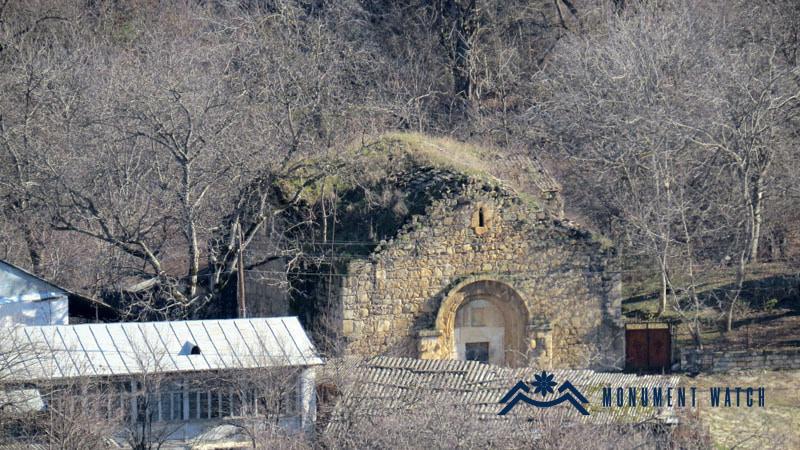
Location St. Astvatsatsin Church of Tsaghkavank is located in the center of Tsakuri village of Hadrut region of the Artsakh Republic, at 866 meters above sea level (Fig. 1). Presently, it is under the occupation of Azerbaijan. Historical overview The village where the church is located, Sargis Jalalyants calls Tsakuri. In the half of the 19th century it had 22 houses with Armenian residents and belonged to the Haykaz Mirzabekyants kin. According to Jalalyants, the construction of the church was not completed, in particular, the dome was not built because the master who built it died. Following the elders, Jalalyants presents an interesting episode from the events that took place during the construction of the church. According to the narrative, the architect gets angry with the apprentice and says: “Let you be bitten by a snake”. It happens that one day while working, the apprentice dies from a snake bite and seeing that and repenting, the architect sculpts a snake’s image on the church in remembrance of the perpetual ones and as an admonition to every miscreant apprentice (Jalaliants 1858, 261-262). Till today that snake sculpture is preserved. It is located in the arched opening of the southern window. Makar Barkhudaryants mentions the monastery, noting that “Above the prayer hall it (the church) used to have a dome, but it is destroyed. Perhaps, it used to be a monastery, then they changed it to a church, which is 15 meters 25 centimeters long and 12 meters wide” (Barkhutariants 1895, 72, 73). The building inscription has been preserved on the lintel of the church, according to which the church was built in 1682: “I – Archimandrite Hakob, from Taghlar borough, from the Tankots kin, a disciple of Archimandrite Yesayi from Krtchevan, was appointed by Yeremia – the Patriarch of Aghuank, as the leader of some northern villages. But they did not allow us to live in our native see and wandering in different places, I did not find a more suitable (place) than this. And I wished to live here, and having leveled Indusar (mountain), I turned it into a residence and began the construction of the cathedral church in memory of my soul and my parents – my father Dalvat and my mother Mariam, and for the pardon of nanny-nurses, my two sisters – Sarah, Yashak. I pray for their lives. The holy church was built by the hands of Archimandrite Hakob in the summer of 1131 (1682). However, the khachkar dated to 1196 preserved in the vicinity of the church gives grounds to suppose that the church was built on the site of an older complex (Mkrtchyan 1985, 116). The longitudinal walls of the prayer hall are accentuated by pilasters on both sides of the arcature (Fig. 3). Architectural-compositional examination The church of Tsaghkavank belongs to the two-pilaster composition of the three-nave basilica type churches. Externally the layout is rectangular (15.24 x 12.10 meters) and almost square inwardly (9.3 x 10.3 meters). The pair of pillars (these are connected by arches, with the wall of bema and the opposite wall pillars) divide the interior space of the prayer hall into medium (4.3 meters) and side (2.0 meters) naves. The side naves end in the east with the vestries adjacent to the main altar (Fig. 2). Stairs leading to the roof are built on both sides of the bema. The only entrance to the church is on the western side, on the east-west axis. The almost quadratic symmetry of the hall is conditioned with arched niches of the wide openings in the southern and northern walls. The longitudinal walls of the prayer hall are accentuated by pilasters on both sides of the pillars (Fig. 3). The interior is plastered, the pillars, arches, niches, the stones of the bema facade are lined with bluish hewn stones, and the walls are made of rough stones (Fig. 4).
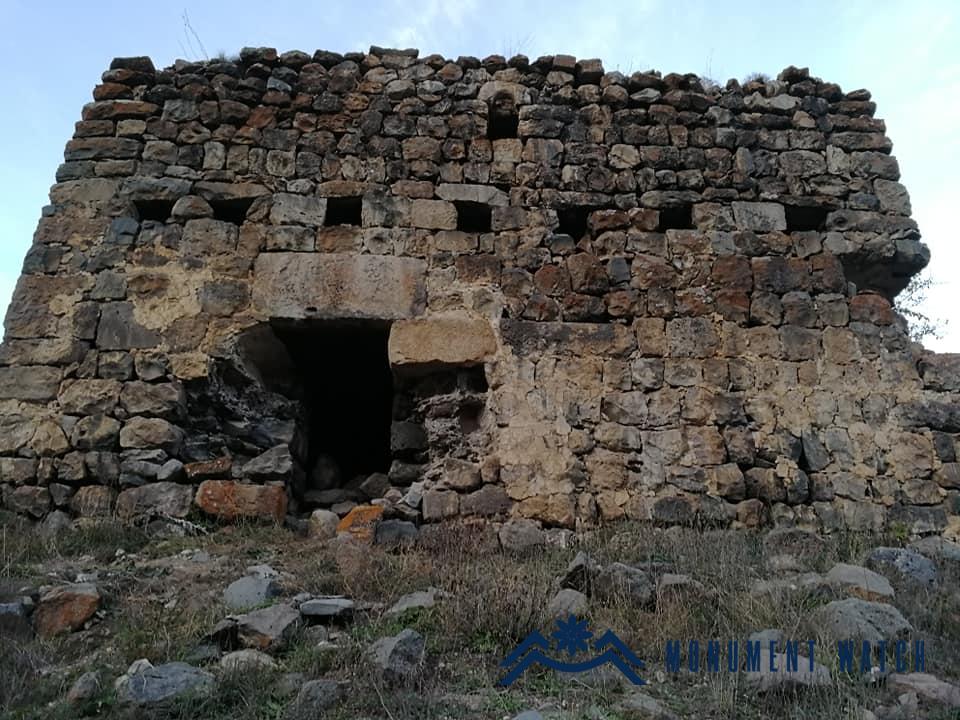
Location The historic village of Stunis is located 2 km south of Ghushchi village (Tandzut) in Kashatagh region (Lachin region) of the Artsakh Republic, on the left bank of the Stunis right tributary of the Aghavnaget River, on its south-eastern slope of gorge. Stunis was first mentioned among the tax-paying villages of Tatev Monastery, and in the 19th century the Kurds settled here, calling the village Sadinlar (Abrahamyan 1942, 42). The old church of Stunis is located about 800 meters north of the village, on the left bank of another tributary joining the Stunis tributary. It is probably a structure of the 9th-10th centuries (Karapetyan 2001, 135). There is no historical information about the church. Architectural-compositional description The church is a single-nave, vaulted building with a horseshoe-shaped altar, lacks any vestries (Fig. 1). It has two entrances, one from the south and one from the west (Fig. 2). It is built on a single-level wall base with raw and semi-finished stones, the corner parts of the walls are demolished (Figs. 3, 4). The dimensions of the church are 8.40X6.10 meters. The lintel of the southern entrance of the church is a polished, one-piece stone, but it lacks any inscriptions or ornaments (Karapetyan 2001, 135). Straightway above the lintel of the southern entrance, along the entire length of the wall, there are small rectangular holes, which suggests that there once used to be a structure attached to this wall. Above the holes, in the center of the wall, there is the only window of the southern wing of the church. The building has another window on the western wall with a primitive horseshoe-shaped window cornice (Fig. 5). The condition before and after the war The church has not been damaged during the Artsakh wars. After the transfer of Kashatagh region under the Azerbaijani control in December 2020, changes and destruction in the area of the monument have not been documented so far.
Location The church (Figs. 1, 2) is located on a hill on the northern side of Tandzatap village (Gharababa) in Kashatagh region of the Artsakh Republic, 21 km north of Kovsakan (Zangelan), 2 km from the current border of the Republic of Armenia.
Location The church (Figs. 1, 2) is located in Kashatagh region of the Artsakh Republic, 15 km west of Sanasar (Kubatli), in Tchapkut village, on the bank of one of the tributaries feeding the Setants rivulet. Presently, it is under the Azerbaijani occupation.
Location The church is located 2-2,5 km south-west of Tzor village of Hadrut region, on a hill rising on the bank of a gorge, at the foot of Tzoraberd (Figs. 1, 2). The village was depopulated of Armenians as a result of the “Ring” operation in 1991, it was liberated in the summer of 1993. The village has been under Azerbaijani occupation since October 2020.
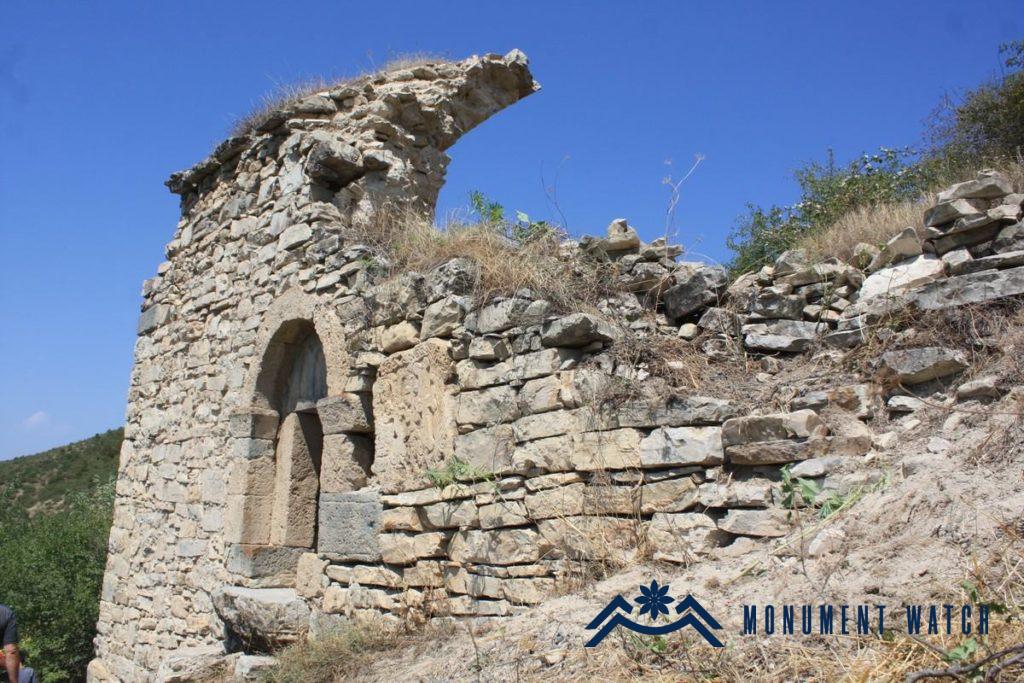
Location The church is located in Harar village of Kashatagh region (Lachin region) of the Artsakh Republic, which together with Khachgetik and Aghavnatun villages is part of Aghavnatun rural community. Harar village is located on the left bank of the Hakari River, at an altitude of 1180-1280 meters (Karapetyan 2001, 172). Historical overview We have written evidence of Harar village since the 17th century. The village is mentioned in the colophons of the manuscripts created locally, where St. Stepanos Church of the village is mentioned as the place of creation of the manuscripts. The next mention of Harar dates back to the 19th century. Accordingly, the majority of the village population was Armenian. The village suffered significantly during the 1905 Armenian-Tatar clashes and especially in 1918. By the 1930s, the village had been depopulated of Armenians and Turkish-speaking Kurds and Azeris had settled on the site (Karapetyan 2001, 172-173). Architectural-compositional description St. Stepanos Church of the village is located at the eastern end of the village, on a steep hillside, it is half-ruined (Fig. 1).
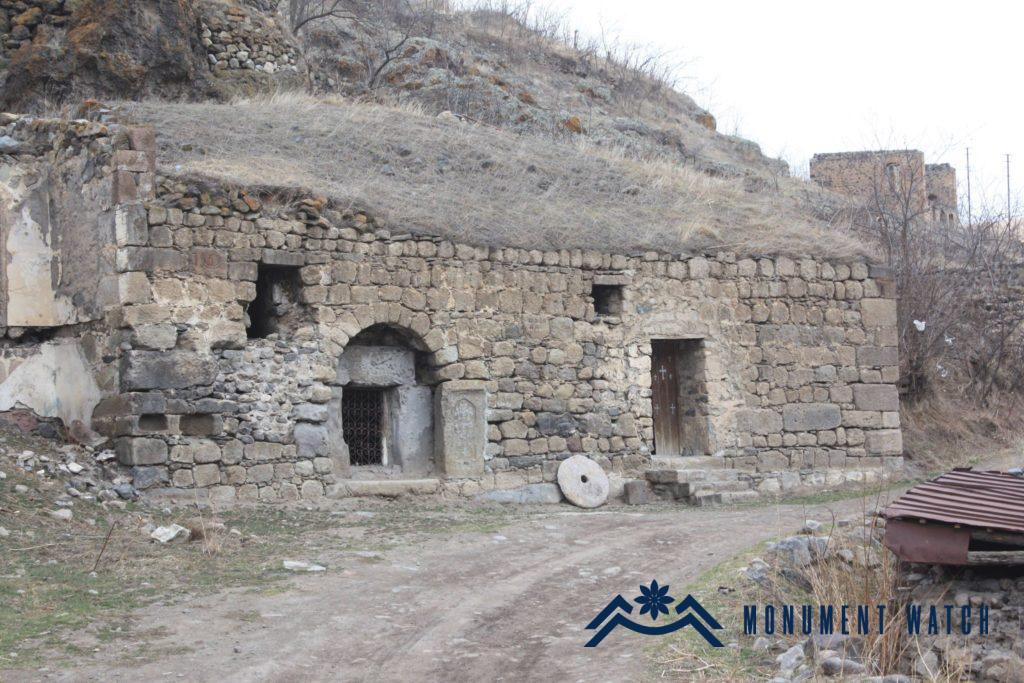
Location The church is located in Herik village of Kashatagh region (Lachin region) of the Artsakh Republic. In the Middle Ages, the village was mentioned as Hayri, Heri, Herik and it was one of the tax-paying villages of Tatev Monastery (Hakobyan 2009, 23-24). In Soviet years it was called Ahmadlu. The village is located on the right bank of the Aghavnaget River, in its upper stream (Karapetyan 2001, 132). Architectural-compositional description The church is located in the center of the village (Fig. 1), it is a single-nave, vaulted church externally with a gable roof which is supported by an arch composed of a pair of pilasters (Fig. 2, 3). It is built of raw stone and lime mortar. The only entrance is from the south, it lacks any vestries (Fig. 4). The baptismal font is inbuilt in the northern wall. The walls of the building are fastened with old gravestones, the entrance lintel is also an old gravestone, and on the right side of the entrance there is an embedded khachkar made of yellow limestone (Fig. 5). The inscription and crosses engraved on the cornice and corbels of the latter were deliberately scratched in the late 1980s. At present, only one line of the inscription on the corbels can be read, which presents the date of the creation of the khachkar: “In the year of 1517”, and in the 1960s it was also possible to read “God have mercy․․․ /” (CAI 1982, 195). The condition before and after the war The Kurds who had settled in the village and later Turkified used the church as a barn, also added a new entrance. During the Soviet years, the church was not subjected to intentional destruction or artificial modifications, only the crosses and inscriptions on the khachkar next to the entrance lintel were scratched. The church was not damaged during the Artsakh wars either. After the transfer of Kashatagh region under Azerbaijani control in December 2020, changes and destruction in the site of the monument have not been documented so far.
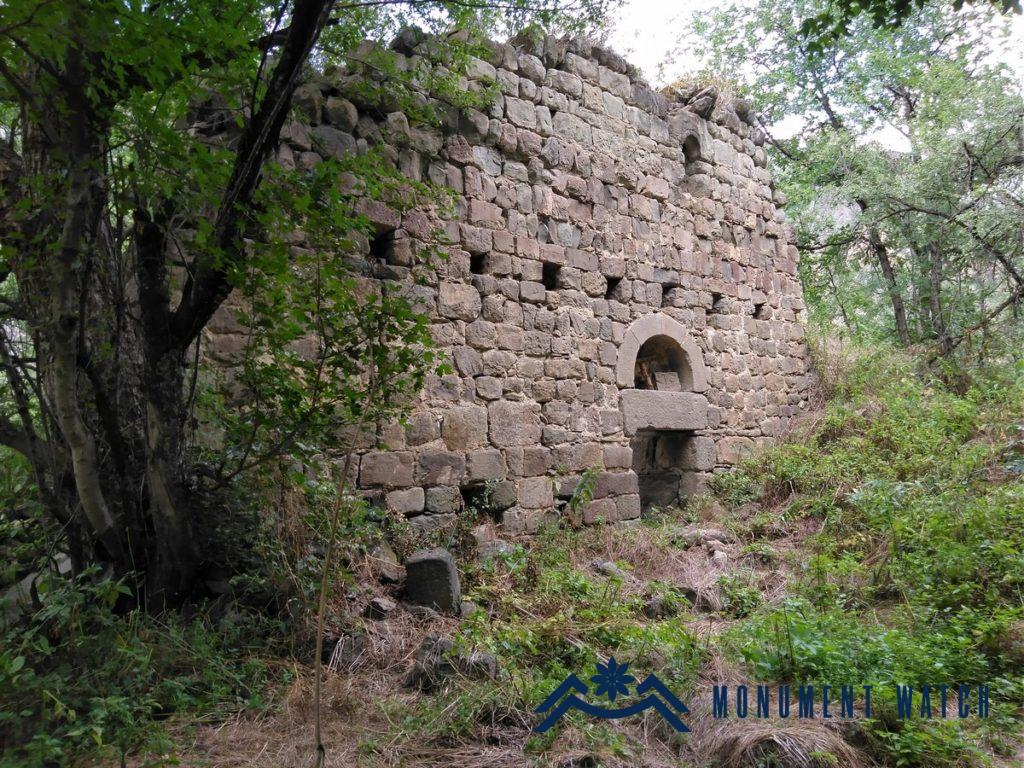
Location Katosavank Monastery is located in Kashatagh region of the Artsakh Republic (now under the control of Azerbaijan), 1 km north of the namesake settlement, on the bank of the Hochants tributary of the Hakari River (Fig. 1). Remains of a basilica church and outbuildings, a cemetery, and remnants of medieval settlements a little east and west have been preserved here. Historical overview There are no known historical data about Katosavank. The probable date of the structure, considering the architectural-compositional solutions and the date of the khachkars scattered in the area, can be considered as the 9th-11th centuries. Architectural-compositional examination The church is built of local rough basalt and lime mortar. Polished stones were used in the segments of building’s entrance, window sills, pilasters and the corners of walls (Fig. 2). The structure is a single-nave basilica with an inwardly accentuated altar on the eastern side with external dimensions of 16.70 x 6.90 meters (Karapetyan 2001, 154, Fig. 3). The thickness of the walls is from 1 to 1.1 meters. In the eastern part, large-sized vestries are attached to the northern and southern sides whose entrances are from outside and do not communicate with the prayer hall. The semi-cylindrical vault (it is completely absent) used to rest on arches rising on a pair of pilasters attached to the northern and southern walls. The church used to have three entrances: from the north, west and south (the latter is well preserved, Fig. 4). It has a preserved window on the southern wall. The vestries of the structure are relatively poorly preserved. The latter also used to have inwardly accentuated altars. The row of horizontal niches on the southern wall of the church suggests that the building had an adjacent hall with a wooden roof from the south (Fig. 5). A contemporary cemetery was spread around the building, from which several khachkars and gravestones of earlier and later periods have been preserved (Fig. 6). The condition before, during and after the war After the cessation of the operation of Katosavank, it mainly suffered during the years under Soviet Azerbaijan. In this period, some of the khachkars of the medieval cemetery were damaged and destroyed, including the inscribed khachkar of Father Grigor (Karapetyan 2001, 154, Fig. 7). Bibliographic examination Researcher S. Karapetyan in his book entitled “Armenian cultural monuments in the region of Karabakh”, also refers to Katosavank Monastery and identifies Katos with Getuz village of the Hakari land mentioned in the manuscript of the Gospel dated 1567 (Karapetyan 2001, 152).







